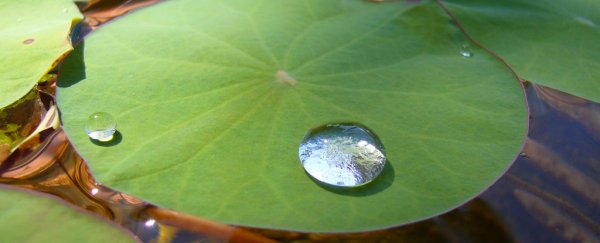There's no doubting that water repellent is a great way to keep clothing, shoes, and all sorts of other products safe and dry from water damage, but it can also involve toxic chemicals that aren't good for us or the environment.
Fortunately, a new water-repellent coating developed by researchers from Rice University is not only environmentally friendly, it's also inexpensive to make. The repellent, composed of a new class of superhydrophobic nanomaterials, takes its inspiration from a humble but nonetheless remarkable example of natural water repelling: the lotus leaf.
"Nature knows how to make these materials and stay environmentally friendly," said chemist Andrew Barron. "Our job has been to figure out how and why, and to emulate that."
The researchers' repellent can be applied to a variety of surfaces via spray- or spin-coating and is hydrocarbon-based, making it an economic and green alternative to conventional fluorocarbon-based repellents that are both hazardous and costly to manufacture.
According to the researchers, the lotus leaf's remarkable ability to repel water is due to its hierarchy of microscopic and nanoscale double structures.
"In the lotus leaf, these are due to papillae within the epidermis and epicuticular waxes on top," said Barron. "In our material, there is a microstructure created by the agglomeration of alumina nanoparticles mimicking the papillae and the hyperbranched organic moieties simulating the effect of the epicuticular waxes."
To qualify as superhydrophobic, a material needs to demonstrate a water contact angle larger than 150 degrees. A water contact angle is the angle at which the surface of the water meets the surface of the material, quantifying the wettability (yes, it's a word) of a material.
The researchers' repellent has an angle of about 155 degrees, making it essentially equivalent to the best fluorocarbon-based superhydrophobic coatings on the market. The findings are reported in Applied Materials & Interfaces.
In addition to helping keep your hiking jacket dry, the researchers say the coating will also be useful in marine applications, especially in environments where water needs to be kept safe from potentially dangerous additives like fluorocarbons.
"The textured surfaces of other superhydrophobic coatings are often damaged and thus reduce the hydrophobic nature," said Barron. "Our material has a more random hierarchical structure that can sustain damage and maintain its effects."
If you want to get a visual sense of how effective the repellent is, check out this video from Rice University below. Just look at those water droplets skedaddle!
